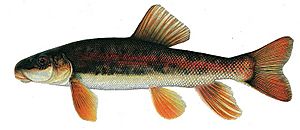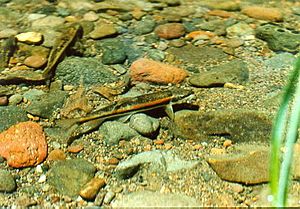Modoc sucker facts for kids
Quick facts for kids Modoc sucker |
|
|---|---|
 |
|
 |
|
| Modoc sucker in spawning colors | |
| Conservation status | |
| Scientific classification |
The Modoc sucker (Catostomus microps) is a special type of freshwater fish. It is quite rare and lives in streams in northern California and southern Oregon. This fish can grow to about 18 centimeters (7 inches) long. It becomes old enough to have babies when it is about 10 centimeters (4 inches) long.
Modoc suckers eat tiny plants called algae, small water bugs (invertebrates), and bits of dead plants and animals (detritus). They like to hide under rocks, plant debris, and plants hanging over the water. This fish is only found in a few streams. Because it is so rare, it is listed as an endangered species in California and the United States. People are working to protect it, for example, by putting fences around streams to keep livestock away. The Modoc sucker used to be listed as "endangered" by a group called the International Union for the Conservation of Nature, but now it is considered "near threatened". This means it is still important to protect them, but they are not in as much danger as before.
About the Modoc Sucker
This fish is a type of sucker. It can start having babies when it is about 8 to 10 centimeters (3 to 4 inches) long. Adult Modoc suckers are usually no more than 18 centimeters (7 inches) long. Very rarely, they can grow up to 33 centimeters (13 inches). Scientists have seen some of these fish live for up to five years.
Where the Modoc Sucker Lives
The Modoc sucker lives in only a few creeks in northern California and southern Oregon. Long ago, they lived in the Ash Creek and Turner Creek areas, which are part of the Pit River basin. They also lived in the Goose Lake basin, which used to be connected to the Pit River. Today, you can find Modoc suckers in ten different streams in this region.
These fish like streams with sandy or rocky bottoms. They also need lots of plant material in the water to hide in. They use overhanging banks, big rocks, and plants for cover. When they are ready to lay eggs, they look for areas with lots of gravel. As mentioned before, their diet includes algae, small invertebrates, and detritus.
Protecting the Modoc Sucker
When the Modoc sucker was first put on the US Endangered Species List, its home was in bad shape. But since then, people have worked hard to make things better. They have put up fences along the streams to keep farm animals away, which helps protect the water and plants. Because of these efforts, the creeks where the fish live are much healthier now.
The area where the Modoc sucker lives is not getting smaller. Other types of fish, like the largemouth bass, have been brought into these waters. However, they do not seem to be a big problem for the Modoc sucker. In 2009, the United States Fish and Wildlife Service suggested that the Modoc sucker's status should be changed from "endangered" to "threatened." This means it would still be protected, but not in as much immediate danger.
The plan was to remove the fish from the List of Endangered and Threatened Species on January 7, 2016. Now, the International Union for the Conservation of Nature officially lists the Modoc sucker as "near threatened."
- Gimenez Dixon, M. 1996. Catostomus microps. 2011 IUCN Red List of Threatened Species. Downloaded on 5 October 2011.
- Froese, Rainer, and Daniel Pauly, eds. (2010). "Catostomus microps" in FishBase. 10 2010 version.
See also
 In Spanish: Catostomus microps para niños
In Spanish: Catostomus microps para niños


